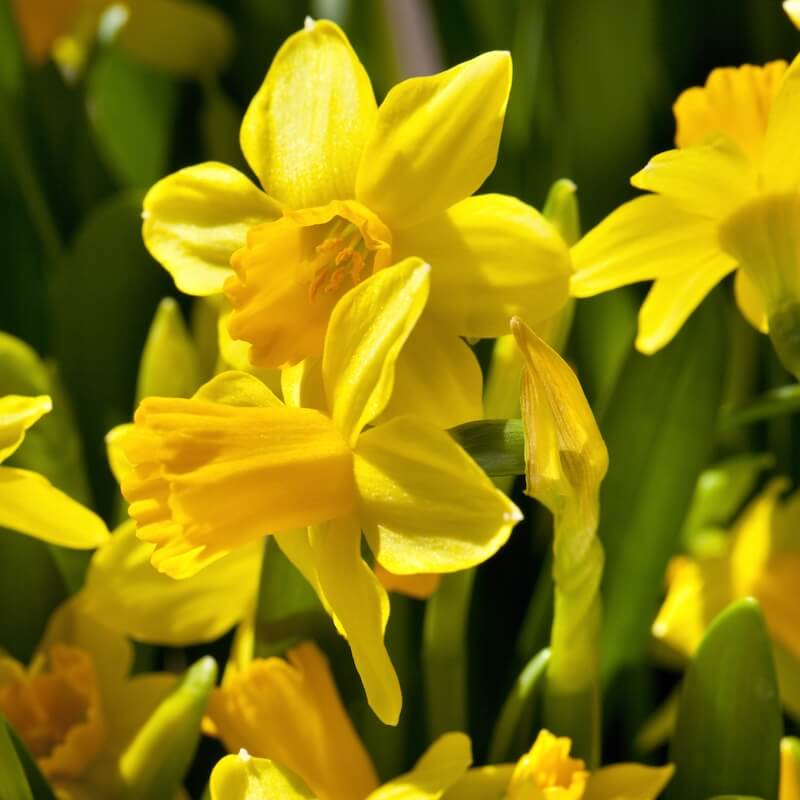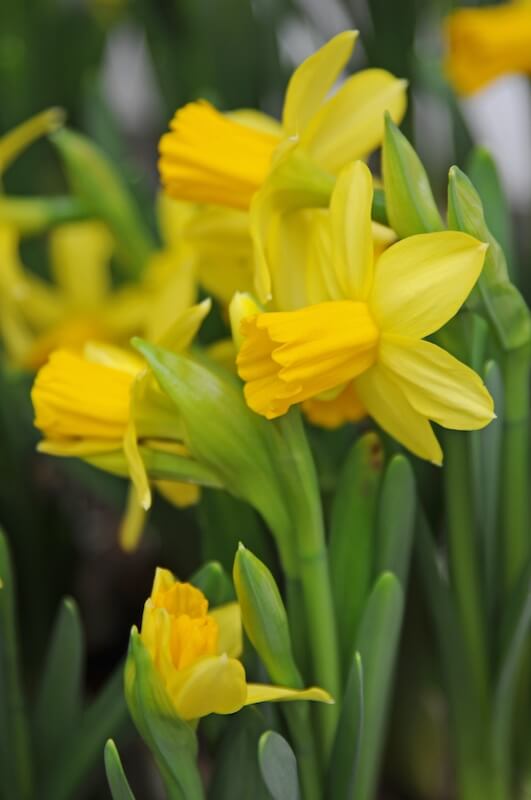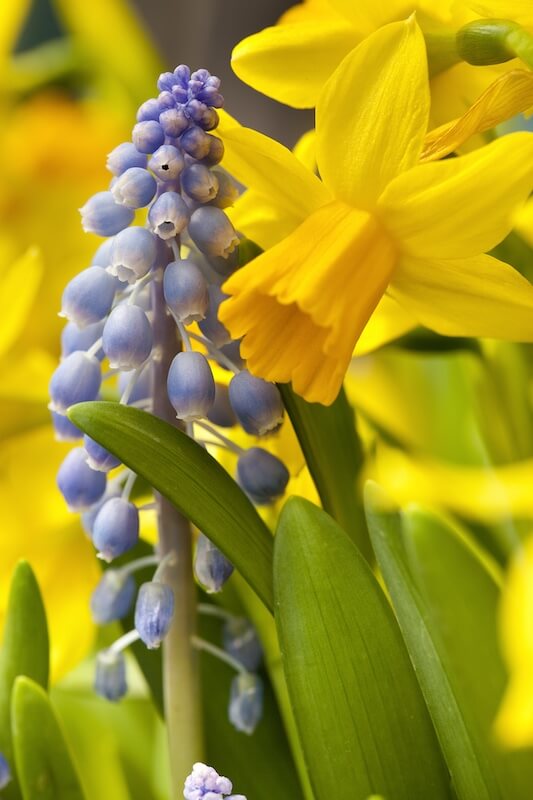
Position
- Plant in full sun to light shade; full sun brings the best flowering
- Ideal for borders, rockeries, gravel gardens or containers
- Prefers a site with good air circulation to prevent damp on the foliage
Hardiness
- Withstands winter lows down to around –20 °C (–4 °F)
- Reliable in all but the coldest, most exposed UK sites; a light mulch over the bulb row helps young plantings
Soil
- Thrives in fertile, well-drained soil
- Benefits from improvement with garden compost or well-rotted manure at planting
- Avoids heavy clay or waterlogged conditions that can cause bulb rot
- Adapts to acid, neutral or alkaline soils
- Performs best where organic matter maintains structure and moisture without waterlogging
- Grab a soil test kit and ensure the perfect conditions for growth
Height
- Consistently reaches 15–20 cm (6–8 in) tall each spring, forming neat clumps that naturalise over time
Seasons of Interest
Additional Notes
- Plant bulbs in autumn, 10–12 cm deep and 7–10 cm apart, for best spring performance
- Divide and replant clumps every 3–4 years once foliage has yellowed, to maintain flower vigour
- Deadhead spent blooms to prevent seeding and encourage bulb energy storage
- Leave foliage in place until fully yellow to allow the bulb to replenish for the following year
- Suitable for pot culture—use a free-draining compost and position in a sunny spot
- All parts are mildly toxic; handle bulbs with care and keep away from pets and children
Narcissus Tete a Tete - Miniature Daffodils with Maximum Impact
If you’re searching for a small yet powerful plant to brighten your garden, look no further than the Narcissus Tete a Tete. This dwarf daffodil has earned its reputation as one of the most popular spring bulbs thanks to its bright yellow flowers, compact growth, and reliable performance. Whether you’re planting in beds, borders, pots, or even window boxes, this little cultivar delivers colour, charm, and joy.
How do you plant Narcissus Tete a Tete bulbs for best results?
Planting Narcissus Tete a Tete is simple, and success starts with choosing quality bulbs in early autumn. Always plant bulbs in early autumn so they have plenty of time to establish roots before winter. Select firm, healthy bulbs that are free of mould or damage, as these will give the best flowers.
When you plant bulbs, choose a spot with well-drained soil. Narcissus bulbs dislike waterlogging, so avoid heavy clay or improve it with grit. Plant each daffodil bulb about three times as deep as its height and space them a few centimetres apart. Planting them in generous clusters creates a natural, colourful display that makes an impact in the spring garden.
Containers and pots also suit these miniature daffodils perfectly. Use a peat-free compost mix, ensuring it stays moist during the growing season but never waterlogged. Place your container in a bright location with full sun for strong, healthy growth.
What makes Narcissus Tete a Tete a standout among spring-flowering bulbs?
Narcissus Tete a Tete is a cyclamineus-type daffodil, which means it carries slightly reflexed petals that sweep back gracefully from the cup. Each stem often produces two or three flowers per stem, offering excellent value from every bulb. These bright yellow flowers appear in early spring, sometimes even before other daffodils bloom, making them one of the first cheerful signs of the season.
This cultivar has won the prestigious Award of Garden Merit from the Royal Horticultural Society, a mark of reliability and outstanding performance. The RHS Award of Garden Merit reassures gardeners that this dwarf daffodil will perform well under typical UK growing conditions. That reliability is one of the reasons it is widely available in garden centres across the country.
Compact and neat, Narcissus Tete a Tete grows only around 15cm tall, which makes it perfect for the front of the border, rockeries, and patio containers. Its golden yellow flowers stand out beautifully against the fresh green foliage.

Why should you choose this dwarf daffodil for your garden?
This popular dwarf cultivar is valued for its cheerful golden yellow flowers and its ability to thrive in many different planting situations. It is an easy-to-grow perennial, coming back year after year with minimal fuss.
Because it stays compact, this miniature daffodil never flops or overshadows other spring bulbs. Its neat growth makes it a reliable choice for borders, pots, and even window boxes. Whether planted in groups or mixed with other spring bulbs, Narcissus Tete a Tete always delivers bright, cheerful colour when most of the garden is still waking up.
The plant’s resilience is another reason to love it. It tolerates colder winter temperatures and reliably returns in spring. For UK gardeners, that means a dependable splash of golden yellow every year with minimal effort.

How can Narcissus Tete a Tete brighten borders and front-of-border displays?
These miniature daffodils are perfect for planting at the front of the border, where their golden blooms can be fully appreciated. Their compact growth ensures they never overwhelm taller plants, yet their bright yellow colour draws the eye.
Plant Narcissus in generous drifts along pathways or borders for a cheerful spring display. They pair beautifully with other spring bulbs like crocuses, grape hyacinths, and tulips. Their golden yellow flowers also contrast nicely with blue and purple blooms, creating vibrant garden colour combinations.
In rockeries, Narcissus Tete a Tete nestles neatly among stones and groundcover plants. Its scale and habit suit smaller garden spaces, making it one of the most versatile spring bulbs for both traditional and modern garden designs.
Can you grow Narcissus Tete a Tete in containers and pots?
Yes, Narcissus Tete a Tete thrives in pots, containers, and even window boxes. This makes it a top choice for patio gardens, balconies, and small spaces where borders aren’t available.
When planting in a container, select a good peat-free compost that drains well. Plant bulbs at least twice their depth and pack them in closely for a full, colourful display. Keeping the compost moist during the growing season is key, but avoid letting water sit in the base of the pot.
Potted plants can be moved around to brighten different parts of the garden or positioned near entrances where their cheerful flowers can be enjoyed up close. Once flowering finishes, allow the foliage to die back naturally so the bulbs recharge for the following year.
What type of soil and light conditions do they prefer?
Narcissus Tete a Tete grows best in well-drained soil. Poor drainage causes bulbs to rot, so always ensure the planting area doesn’t hold water. If your garden soil is heavy clay, mix in grit, sand, or organic matter to improve structure.
These miniature daffodils thrive in full sun, though they can also tolerate partial shade. Planting in a bright, open spot encourages stronger stems and a better bloom. In shadier areas, they may still flower, but stems can be slightly weaker.
During growth, soil should be kept moist, but not waterlogged. This balance ensures bulbs remain healthy, producing lush foliage and plenty of flowers in early spring.
What is special about the flowers of Narcissus Tete a Tete?
The flowers of Narcissus Tete a Tete are instantly recognisable. Each bloom features a deep golden yellow trumpet surrounded by a perianth of slightly reflexed petals. Flowers appear in early spring, often when the rest of the garden is still bare.
Unlike taller daffodils, this miniature produces multiple flowers per stem. That means a bigger display from fewer bulbs, which makes planting them even more rewarding. Their bright yellow flowers bring cheer to borders, containers, and patios at the start of the season.
These yellow flowers also hold up well against spring rain and wind. Their shorter stems prevent damage, ensuring displays remain neat and cheerful throughout the blooming period.
How should you care for Narcissus Tete a Tete after flowering?
Once flowering finishes, it’s essential to let the foliage die back naturally. Don’t cut leaves off too early, as they help recharge the bulb for next year. Allow the foliage to yellow before removing it, usually six to eight weeks after bloom.
Deadheading spent flowers prevents energy from going into seed production and directs it back into the bulb. This small step helps ensure a stronger display the following spring.
Narcissus bulbs are perennials, so with the proper care, they return year after year. Over time, clumps may become crowded, but you can lift and divide them in late summer or early autumn to refresh displays.
What makes Narcissus Tete a Tete a reliable perennial?
Narcissus Tete a Tete is valued as a perennial because it returns each year with consistent performance. This resilience is one of the reasons it holds the RHS Award of Garden Merit.
These bulbs store enough energy to survive winter and re-emerge in early spring without extra effort from the gardener. By planting them once, you set up years of cheerful golden displays. With well-drained soil, enough sunlight, and correct care, the bulbs remain productive for many seasons.
The fact that Narcissus Tete a Tete naturalises easily also adds to its appeal. Over the years, groups expand and fill larger areas, creating carpets of golden yellow that brighten the spring garden.
Why is Narcissus Tete a Tete a popular choice in garden centres?
Narcissus Tete a Tete is one of the most popular dwarf daffodils in the UK, and with good reason. Its compact size, reliable flowering, and cheerful colour make it a perfect choice for both beginners and experienced gardeners.
Garden centres stock it widely each autumn because demand remains high. Shoppers trust it as a proven cultivar with an excellent record of performance, backed by the Royal Horticultural Society’s prestigious award of garden merit.
Whether sold as dry bulbs or ready-potted plants, Narcissus Tete a Tete appeals to anyone who wants quick, easy spring colour. It is truly one of the most dependable spring bulbs for gardens, patios, and containers across the country.
From Darren’s Patch
I love how Narcissus Tete a Tete never fails to lift the spirits in early spring. In my garden, I plant them in generous drifts along borders and in pots near entrances, so their golden blooms are the first thing I see on a chilly morning. Their compact size and multiple flowers per stem make them perfect for small spaces, yet they still create a cheerful impact that belies their stature. What appeals to me is their reliability — year after year, they return with minimal fuss, brightening the garden when so little else is in bloom. I often mix them with early crocuses or grape hyacinths for added colour contrast, and I’ve found that letting the foliage die back naturally keeps the bulbs strong for the following year. For any gardener seeking dependable, joyful spring colour, these little daffodils are simply a must.
![]()
Key Points to Remember
- Plant bulbs in early autumn in well-drained soil or containers
- Flowers appear in early spring with bright golden yellow blooms
- Compact growth makes them ideal for borders, rockeries, and pots
- Each stem produces multiple flowers per stem for a fuller display
- Allow foliage to die back naturally after flowering
- Keep soil moist during the growing season, but avoid waterlogging
- Full sun encourages the most vigorous stems and brightest blooms
- Holds the RHS Award of Garden Merit for reliability and performance
- Perfect as a perennial, returning year after year with little fuss
- Widely available in garden centres as both bulbs and potted plants
Narcissus Tete a Tete is an easy, reliable spring bulb for UK gardens, flowering at 15–20 cm (6–8 in) tall from February to March in sun or light shade on well-drained, improved soils of any pH. With simple spring dead-heading, autumn replanting of clumps and foliage left to yellow, it naturalises beautifully in borders, rockeries or containers.
Want to learn about other bulb varieties? Read about Narcissus Tete Boucle here.
For more information on Spring Flowering Bulbs for your garden, please click here.

Frequently Asked Questions
Q: What is Narcissus Tete a Tete?
A: Narcissus Tete a Tete is a popular dwarf daffodil cultivar admired for its golden yellow flowers that appear in early spring. This miniature daffodil belongs to the cyclamineus group, producing two or three flowers per stem with slightly reflexed petals and a neat perianth. It is an easy-to-grow perennial that thrives in both borders and containers, often brightening window boxes, rockeries, or the front of the border. Recognised by the Royal Horticultural Society with the prestigious Award of Garden Merit, it is a dependable choice for spring gardens across the UK.
Q: How do you plant Narcissus bulbs for the best results?
A: When you plant narcissus bulbs such as Narcissus Tete a Tete, choose a spot with full sun and well-drained soil. For best results, plant bulbs in early autumn, placing each daffodil bulb about two to three times its depth and several widths apart. Spring flowering bulbs like these prefer moist soil during the growing season, but must not sit in waterlogged conditions. In containers or pots, ensure adequate drainage and space bulbs evenly. With the proper planting approach, these spring bulbs will reward you with bright yellow flowers and healthy foliage that returns reliably each year.
Q: Where can I buy Narcissus Tete a Tete bulbs or plants?
A: Narcissus Tete a Tete is widely available across the UK, making it easy to find for your spring garden. You can purchase narcissus bulbs from garden centres, nurseries, and major retailers, both in-store and online. Many suppliers also offer potted plants for patio displays or window boxes, allowing you to enjoy instant seasonal colour. As one of the most popular dwarf narcissus cultivars, it is regularly stocked and offered in bulk packs, making it suitable for large borders or smaller container displays. Buying early ensures the best selection of high-quality flower bulbs for a reliable spring bloom.
Q: What makes Narcissus Tete a Tete ideal for small gardens?
A: Narcissus Tete a Tete is a popular dwarf variety, making it perfect for compact spaces such as patio pots, window boxes, or rockeries. Its deep golden yellow flowers appear in early spring, offering vibrant colour when little else is in bloom. Because these miniature daffodils only reach around 15 cm tall, they work beautifully at the front of the border or in narrow beds. Each stem can carry multiple flowers, extending the display in smaller gardens. Their compact growth, ease of planting, and reliable bloom make them a firm favourite for spring bulbs in confined outdoor spaces.
Q: How do you care for dwarf daffodils after flowering?
A: After flowers appear and begin to fade, allow the foliage of dwarf daffodils like Narcissus Tete a Tete to die back naturally. Do not cut the leaves early, as they help feed the bulb for next year’s display. Keep the soil moist during the growing season, then reduce watering once foliage has withered. In containers, potted plants can be stored in a cool, dry place until bulbs are ready for replanting. With proper aftercare, narcissus bulbs will bloom reliably each spring, producing golden yellow flowers per stem that enhance any perennial planting scheme.
